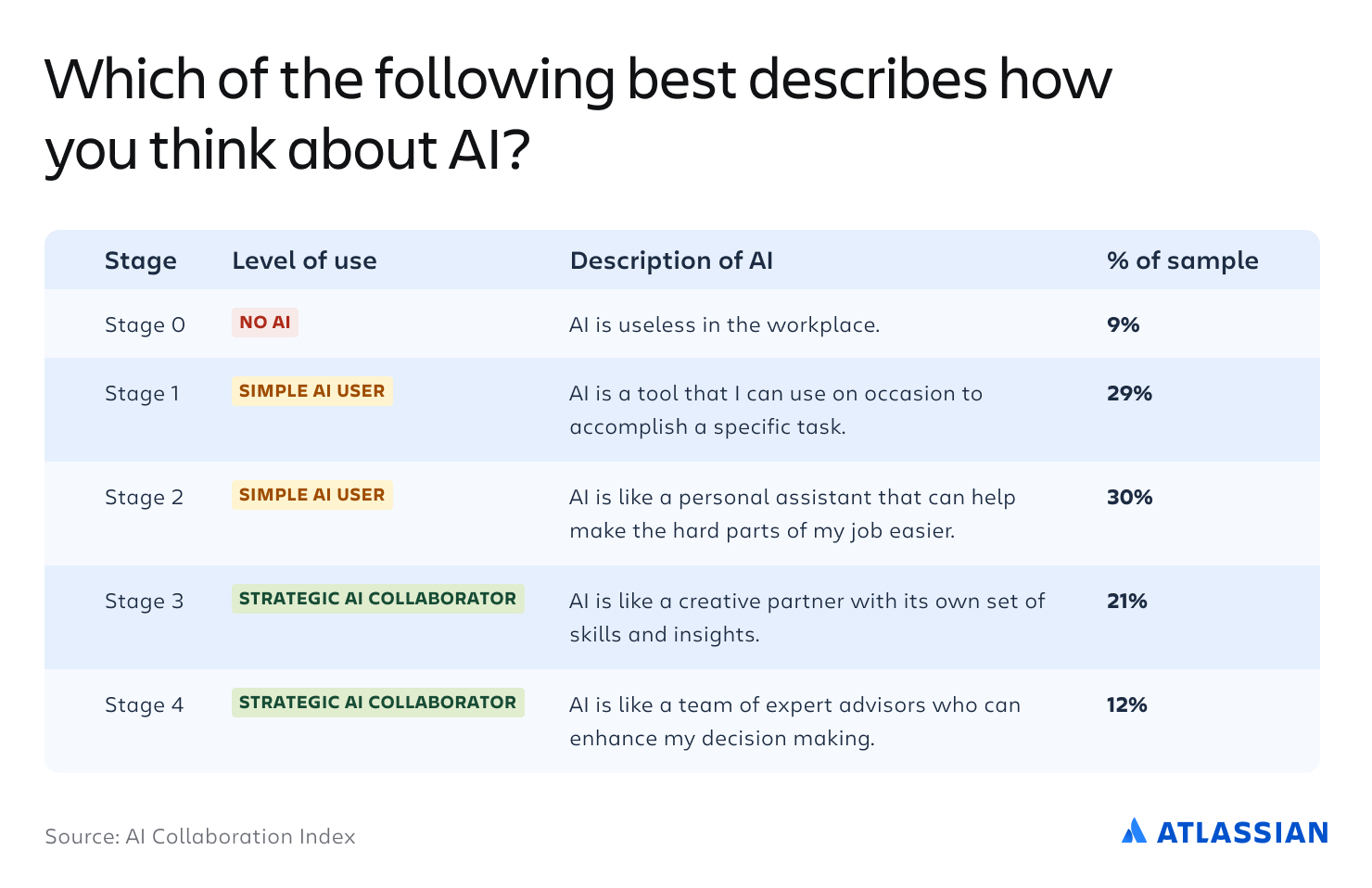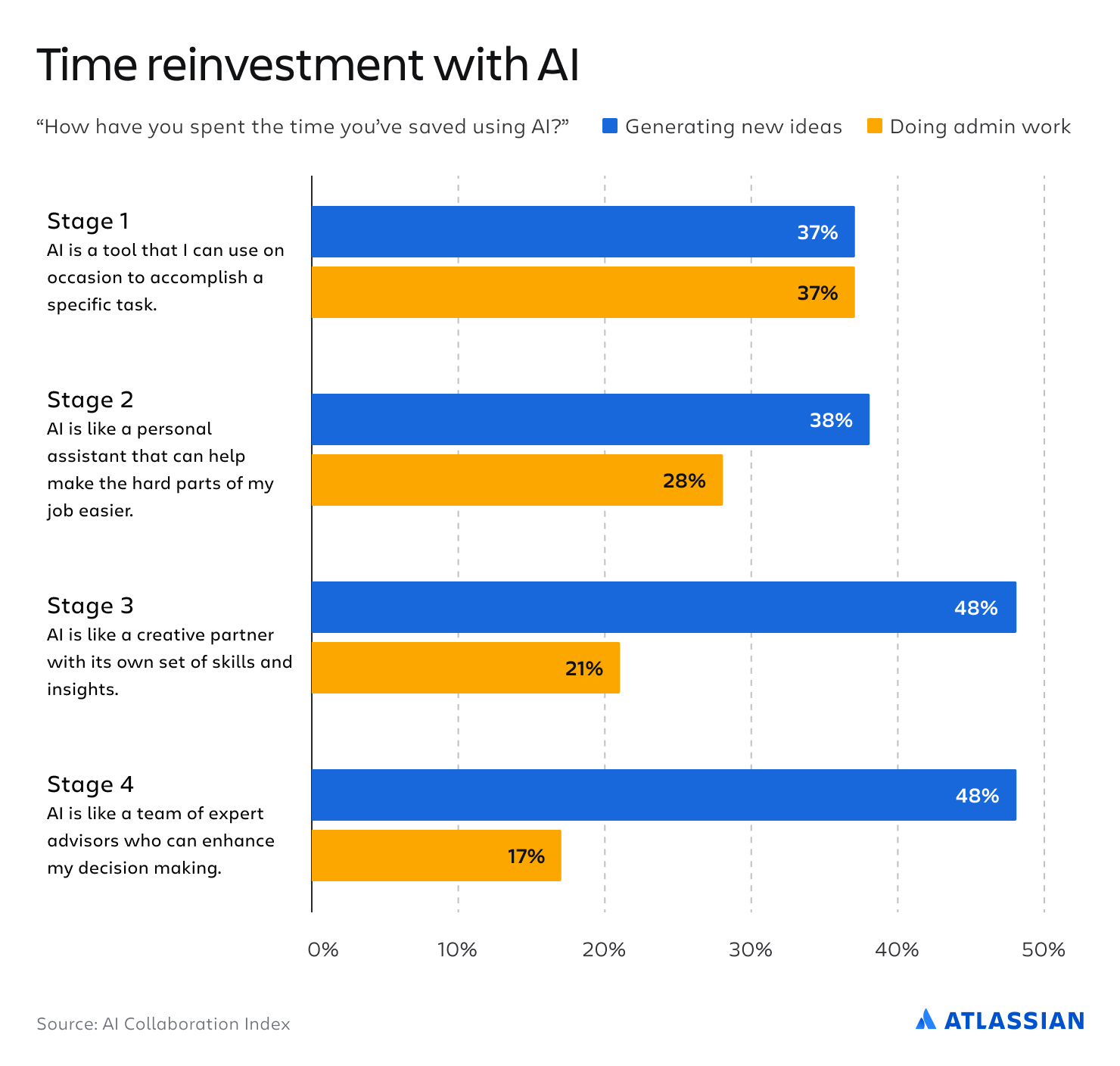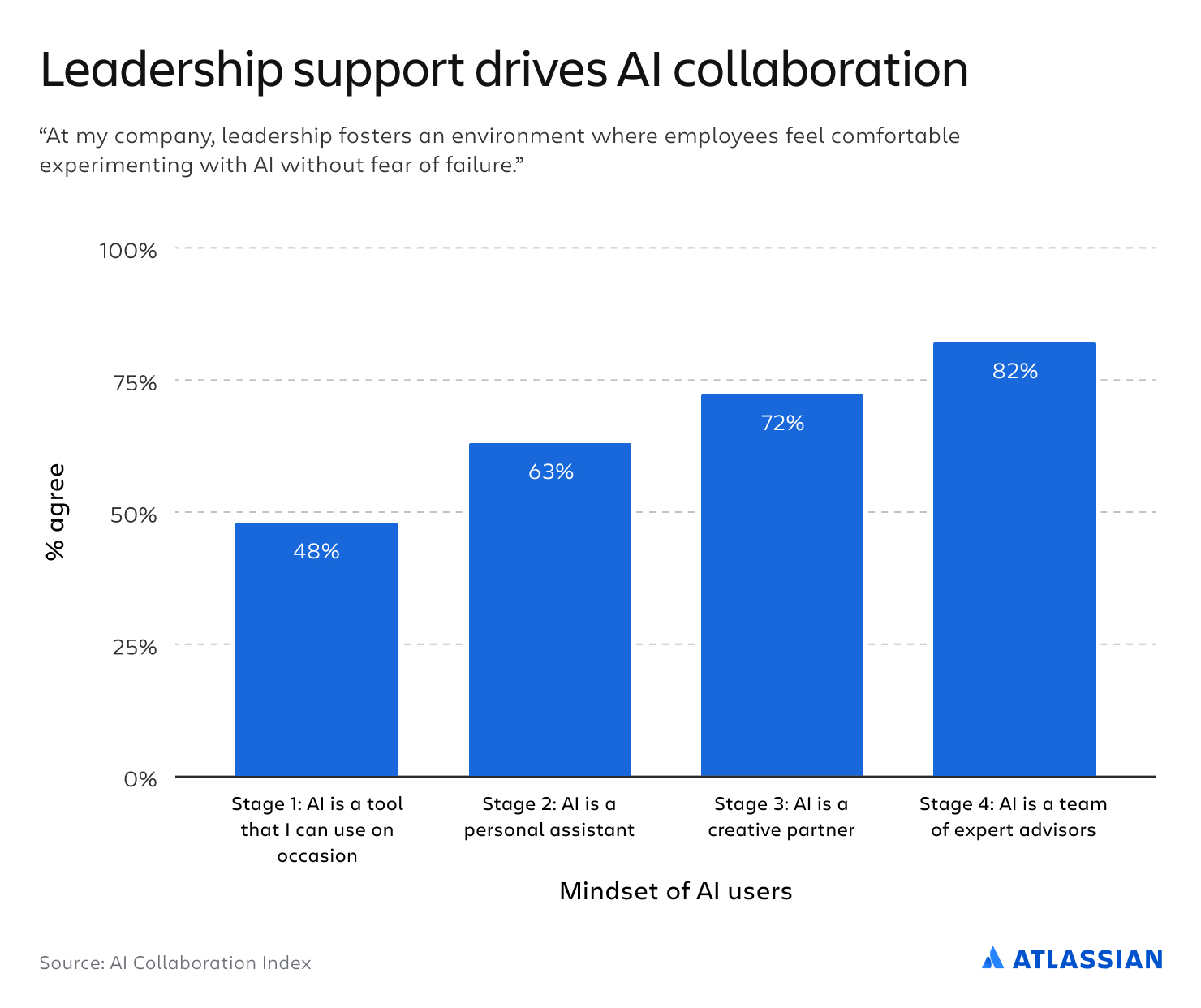Stop “using” AI. Start collaborating with it.
Our latest research from Atlassian’s Teamwork Lab shows that when it comes to getting the most out of working with AI, mindset matters far more than adoption – and is key to maturity.
Advancing past adoption
Much existing research focuses on AI adoption rates, or how often someone uses AI. We take a different approach to instead look at how people work with AI. Our data clearly shows that employee mindset is the key to AI maturity. In other words, adoption matters far less than attitude when it comes to optimizing AI capabilities and improving work quality within an organization.
Our data reveals two primary groups of people who engage with AI at work: one group sees it as a tool, while the other treats it like a team of expert advisors. People in the second group don’t just use AI to automate repetitive tasks, they experiment with AI to bring their ideas to life. Unsurprisingly, we see that the quality of their work is much higher than that of simple AI users.
Some people think of AI as a way to do the work they don’t want to do. Top performers think of it as a way to do the work they’ve always wanted to do.
In our survey of roughly 5,000 knowledge workers from Australia, US, India, Germany, and France, we see that people who most effectively collaborate with AI start with a question. These individuals define a specific task or challenge, set a clear goal, and then partner with AI to brainstorm solutions, explore ideas, and deliver better work.
The results are clear: the future of work is human-AI collaboration. Our data proves that the most strategic AI collaborators:
- Leverage AI to get 2x the ROI on their efforts
- Save 105 minutes daily – equal to an extra workday each week
- Are 1.5x more likely to reinvest time saved into learning new skills
- Are 1.8x more likely to be viewed as innovative teammates
So, what’s preventing your team and company from reaping the benefits of human-AI collaboration? See the key findings from our inaugural AI Collaboration Report and learn how to move your people from AI users to AI collaborators.
The AI Collaboration Index: from simple user to strategic collaborator
For our AI Collaboration Report survey, we asked participants to report how they think about and work with AI.

We then grouped participants into two main categories:
- Simple AI users (those in Stages 1 and 2) think of AI as an automated tool. They use AI only to get tasks they could likely do themselves done faster and more easily. Think: personal assistant.
- Simple usage examples (Stage 1 and 2):
- You wrote an email, and you use AI to make it more concise and effective.
- You use AI to search for information within your company.
- Simple usage examples (Stage 1 and 2):
- Strategic AI collaborators (those in Stages 3 and 4) approach AI as a creative partner or an entire team with a range of specialized skills.
- Strategic collaboration examples (Stage 3 and 4):
Anu Bharadwaj, President of Atlassian, collaborates with the Customer 360 agent to quickly pull customer data into a page and then spars with the agent to surface insights. AI agents like Customer 360 act as specialized teammates by informing strategy:
Annie Dean, Global Head of Team Anywhere, Atlassian, leverages AI to speed up and improve real-time idea generation:
If you’re stuck on an idea and your favorite sparring partner is tied up in a meeting, you can open a conversation with AI to bounce ideas back and forth, get feedback in real time, and treat the exchange like a true conversation. For the first time, technology speaks our language – and that’s a huge unlock.
Annie Dean, Global Head of Team Anywhere, Atlassian
Note: Respondents who identified AI as “useless in the workplace” (Stage 0) were not included in these analyses, as they did not actively use AI in their workflow.
The most strategic AI collaborators see 2x the ROI of simple users
We asked people to estimate the amount of time that AI saves them on a daily basis. Simple AI users (specifically, those in Stage 1) save 53 minutes per day thanks to AI, while the most strategic AI collaborators (those in Stage 4) save a whopping 105 minutes per day. That’s equal to over 20% of the average workday, or an entire extra workday each week.
Translating our results to dollars: enterprise organizations that partner with AI for enhanced decision-making can achieve an ROI of $129.4 million annually, compared to just $65.1 million when AI is used for task-specific purposes. That’s an opportunity cost of $64.3M.
Nearly all of Stage 4 AI collaborators (94%) agree that the time they spend learning to work with AI pays off, compared to just 59% of Stage 1 AI users.

By moving employees beyond basic AI usage to strategic collaboration, companies can capitalize on AI’s full potential and drive significant ROI. But shifting your AI mindset is not just about time savings – it’s much bigger than that. AI collaboration can give companies an additional competitive edge by promoting continuous improvement, elevating work quality, and fueling meaningful innovation.
Strategic AI collaborators reinvest time saved to level up – simple AI users don’t
There are not only big differences in how much time simple AI users and strategic AI collaborators save, but in what they do with that time. Simple AI users save 53 minutes per day thanks to AI, and tend to spend that extra time on administrative tasks.
In contrast, strategic collaborators take the 105 minutes per day that they save to dive more deeply into their work: they are most likely to keep learning new skills and generating new ideas. Our data shows that those in Stage 4 are most likely to report that AI has increased their motivation and excitement about work. These collaborators are energized by the innovation and possibilities of AI, and continue to discover new ways it can help them become more creative and productive.

If simple AI users adopt a collaborative approach, they may become more motivated and keep uncovering new ways to leverage AI. As an added benefit, feeling energized at work is linked to higher job satisfaction and lower levels of burnout. Human-AI collaboration seems to be a self-perpetuating cycle: strategic ways of working with AI lead to higher payoffs, which encourage further exploration and experimentation and have a snowball effect on organization-wide innovation.
Strategic AI collaborators get higher-quality results
We see the greatest unlock when workers start to view AI as part of the team. This is when the quality of their work jumps up. Simple AI users get things done fast, but their work quality doesn’t seem to change. As someone becomes a more strategic AI collaborator (Stages 3 and 4), not only do they get work done faster, but the quality of their work also improves drastically.
- Roughly half of Stage 1 simple AI users (54%) agreed that “The quality of my work has improved over the past month.”
- In contrast, a large majority (85%) of strategic AI collaborators (Stage 3 and 4) agreed that “The quality of my work has improved over the last month.”
But how exactly does strategic collaboration improve work quality? When simple users have AI compile data from various sources, they stop there. They fail to ask AI to help with analysis or takeaways. In contrast, a Stage 3 collaborator will continue to work with AI to build hypotheses, ask questions, analyze findings, and pull insights.
A Stage 4 collaborator takes it one step further. They ask AI to outline the pros and cons of different decisions, surface case studies from similar contexts, and list potential unintended consequences. Teams that tap into AI’s deep knowledge base can produce higher quality and more impactful work, driving strategic outcomes that solve a larger business problem.
Our research shows Strategic AI collaborators are 1.8x more likely than simple AI users to be seen as innovative teammates. Their AI experimentation not only enhances their own work but inspires team-wide creativity and problem-solving.

Teams that collaborate with AI can see exponential gains in both performance and output, setting their organizations apart from the competition. Leaders should highlight instances where a strategic collaborator partnered with AI to improve the quality of their work, and have that employee share exactly how they integrated AI into their workflow with the larger team. This provides actionable insights and best practices for others to replicate, and raises the standard across the organization.
Strategic AI adoption varies across functions
Different functions leverage AI in different ways, with some clear missed opportunities. Less than half of even the most strategic AI collaborators in IT currently turn to AI for higher-level work, like developing long-term plans, optimizing resource allocation, and building and testing new solutions. And of all marketers, only 31% say AI helps them create insights from complex data. As marketing is becoming increasingly quantitative, this stands out as an overlooked area for collaboration.
Another example: the most strategic AI collaborators in management and strategy roles are, unsurprisingly, also the most likely to turn to AI for help creating insights from complex information or data. Among these employees, 67% report leveraging AI for this task. In contrast, less than a third of Stage 4 employees in education and training do the same.
By encouraging cross-functional knowledge sharing, leaders have an opportunity to improve AI collaboration within specific functions. While the details of how teams work with AI may be craft-specific, simply hearing that another function is leveraging AI in a certain area (e.g., translating data into insights) can unlock new forms of experimentation and set the stage for a crowd-sourced culture of AI collaboration ideas.
Leadership attitude towards AI matters – a lot
Whether they know it or not, leaders set the tone for AI collaboration at work. In an environment of fear and anxiety around AI, workers will use it minimally and may hesitate to spend the time to learn more innovative methods of collaboration. Think, ”If I use it, I’m cheating … so I’ll keep it basic” or “If I take time away to figure out how to use AI, I’ll get behind on my work. So I’ll just keep working like I always have.”
If leadership embraces experimentation and motivates employees to try and learn AI without fear of failure – or productivity loss – workers develop their strategic AI collaborator muscle more readily. Those who agree with the statement “Leadership encourages me to experiment with AI” save 55% more time a day than those who don’t (84 minutes vs. 55 minutes). We also see that those with leadership support are 2.5x more likely to be strategic AI collaborators.
But support alone isn’t enough. Leaders must make their own AI collaboration journey visible. If you’re a leader, a powerful way to move your people beyond AI “usage” is to give them examples of how AI helps you augment your work. Start team meetings off by sharing what agent you or your team recently leveraged and offer best practices for prompting it. Consider creating a platform (this could be a Slack channel or company-wide newsletter) with other leaders to do the same. Taking these steps will not only offer employees insight into how to better work with AI, but will also set a norm of human-AI collaboration.
When leaders foster a culture of experimentation and learning, employees are more likely to become strategic AI collaborators, resulting in greater time savings and higher-quality outcomes. Without leadership support, workers may stay stuck in outdated workflows (and in Stage 0-2), missing out on AI’s ability to drive efficiency and innovation. Embracing AI at the leadership level is key to unlocking its transformative benefits across the organization.

How teams can become strategic AI collaborators
Having leadership support is just half the equation; developing a culture of AI collaboration is a team effort. Here are a couple of practical steps to get you started:
- Foster AI experimentation by encouraging everyone to embed AI into their daily work. Don’t just attend an hour-long training session. Instead, encourage your team members to take a more hands-on approach to learning by setting weekly challenges for the group like, “Try two new AI agents this week. Here are some agents we’ve been working with…” or “Ask AI four questions this week.”
- Host cross-functional learning sessions focused on AI collaboration. Consider adding a segment to team-wide meetings in which different people highlight how they’re leveraging AI to improve their work. Make this a rotating role. If each person knows in advance they’ll be asked to share their AI collaboration best practices, they’ll be more likely to establish and adopt better ways of working with AI.

Looking ahead
Based on the findings detailed above, we predict:
- Burnout will decrease by 25%, driven by a 50% burnout drop among Stage 4 AI collaborators. AI leads to time savings across the board, but people in Stage 4 also report that AI increases their motivation and excitement about work. These trends should reduce work-related overwhelm, leading to noticeable improvements in employee wellbeing.
- The AI ROI gap will double. Strategic AI collaborators see 2x the ROI of simple users, but as they continue to experiment and develop new ways to collaborate with AI, we expect they’ll see 4x the ROI by 2026.
- In 2025, individuals with strong people management skills will get 75% more value from AI agents – even if they aren’t in leadership roles. The skills that make great people leaders – providing context about the problem, assembling the right team of experts, and delegating work – are the same skills needed to successfully use AI as a creative partner and team of expert advisors.
Our findings show that strategic AI collaborators see higher ROI, work quality, and motivation. The implications are clear: the most successful teams will be those who advance beyond simple AI usage. It’s time for us to reset how we work with AI – from treating it as a basic tool to partnering with it as a collaborative teammate.





 )
) 





































